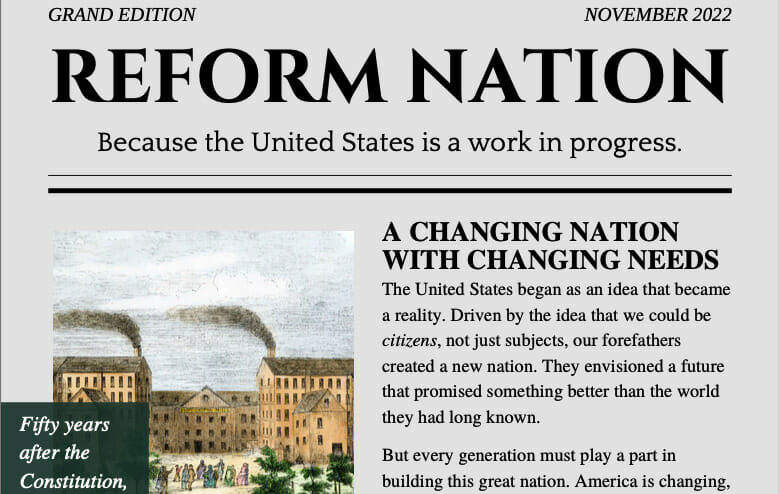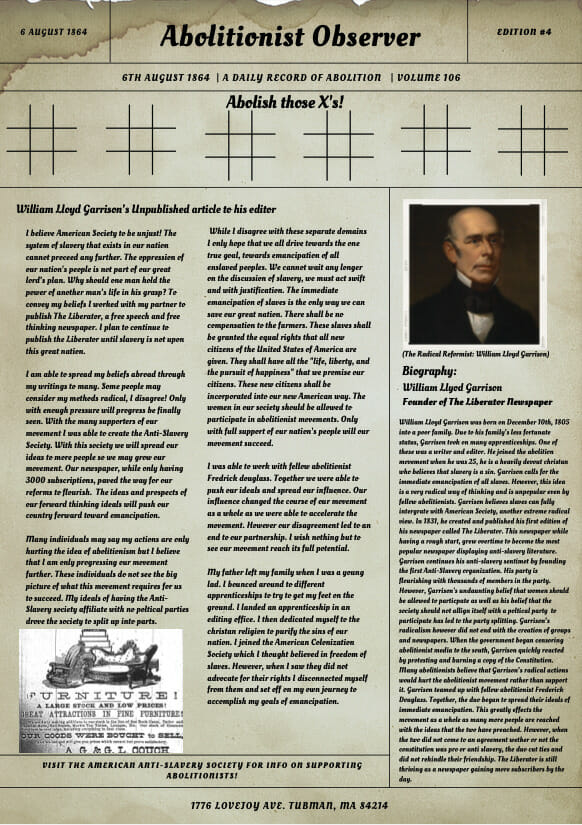What responsibility do you have to change the world? Dr. Tanya Roth’s 10th-grade accelerated history students pondered this question as they worked on a collaborative and research-driven antebellum social reformers project this semester. In the early-mid 19th century, Americans from all walks of life began grappling with the state of the nation. Some were inspired by the Second Great Awakening, others by lived experiences or observations. No matter how they began, no matter what they fought for, these activists all worked to make the nation a better version of itself. The students assumed the identities of antebellum reformers in the United States, such as Frederick Douglass, Sylvester Graham, Elizabeth Cady Stanton, and Brigham Young. The young historians spent time researching each reformer’s activism in the pre-Civil War years, trying to understand the efforts Americans were making to improve their country.
This year, the students made newspapers, writing as their reformers and working together to create materials. All students working on Education reformers created one section of a newspaper: Women’s Rights advocates, Utopians, Abolitionists, and Temperance reformers. Each group member wrote an individual piece and collaborated to co-author other pieces.
As they wrote, they considered these questions:
- What criticisms of American society did the individual have?
- What methods did the person use to improve American life?
- What successes/failures did the individual have in promoting reform?
- What were the major beliefs of the individual?
- How influential was the activist during their lifetime?
- What influences in early life led the individual to be an activist?
Read the C Period newspaper (click image to open full PDF):
GT Cozad ’25 said, « Writing a newspaper was something very unique and interesting for me, personally, because I’ve never done a project like it. Although I had my doubts, the newspaper turned out to be one of the most enjoyable projects of the year; it fostered creativity and research and encouraged students to write from the perspective of their reformer. »
« I really loved working on this project because not only did we get to research our own social reformer, but we got to work with a group and see how these reformers’ movements may have overlapped in order to create change, » said Alyssa Harris ’25. « My group focused on women’s rights, and it was interesting to learn more about the pasts of American women and how they were able to fight for change in multiple ways, though they were often looked down upon. I loved getting to hear back from the sixth-grade students, and I was excited that they were able to easily grasp information about our social reformers from our newspapers. Getting feedback from the 6th graders was really eye-opening because I got to see my writing from another perspective. »
Read the G Period newspaper (click image to open full PDF):
To add a new layer this year, those newspapers went to the sixth-grade history classes, where the students read the newspapers and used the information to consider specific questions about the United States in the pre-Civil War years. Then, the sixth graders wrote « Letters to the Editors » responses back to the reformers. Cozad enjoyed reading their responses. « Getting responses from sixth graders about the article was a bonus! » he said.
Timo Finnegan ’29 and Vihari Battula ’29 wrote back to Horace Mann. They said, « Dear Horace, we agree with what you are fighting for. I love the thought that all people should be given a good education, poor or not. Your schools also provide the right education taught from professional teachers, educating the next generation. You are also allowing all people to apply and learn how to be a teacher, which I agree with. I think this follows the natural rights that everyone is given Life, Liberty, and Happiness, because no matter the gender or social class, they receive the same great education. »
« I found the Antebellum Social Reformers Project to be a unique and effective take on summarizing the various reformer ideologies circulating in the nation in the first half of the 19th century, » said Abhinav Katyal ’25. « It took a lot of work to complete, but seeing the end result of our group was rewarding. The sixth-grade responses were effective and provided intuitive analysis of each of our reformer articles, which was quite helpful. »
Dr. Roth credits JK-12 History and Social Sciences Department Chair Carla Federman and Sixth Grade History Teachers Mark Duvall and Megan Caulfield for their help in coordinating this cross-divisional project.
Well done, Upper and Middle School historians!


